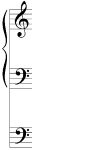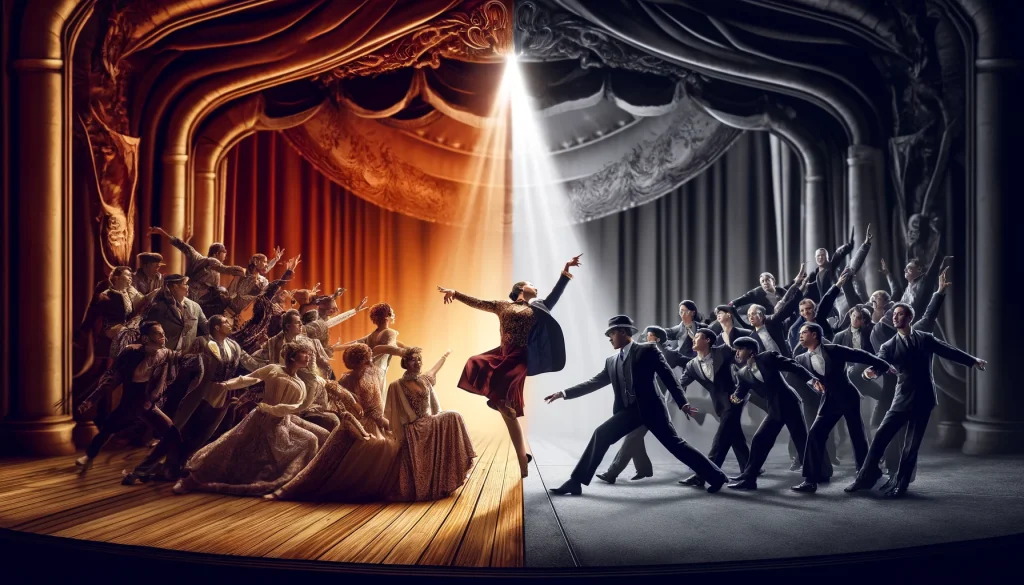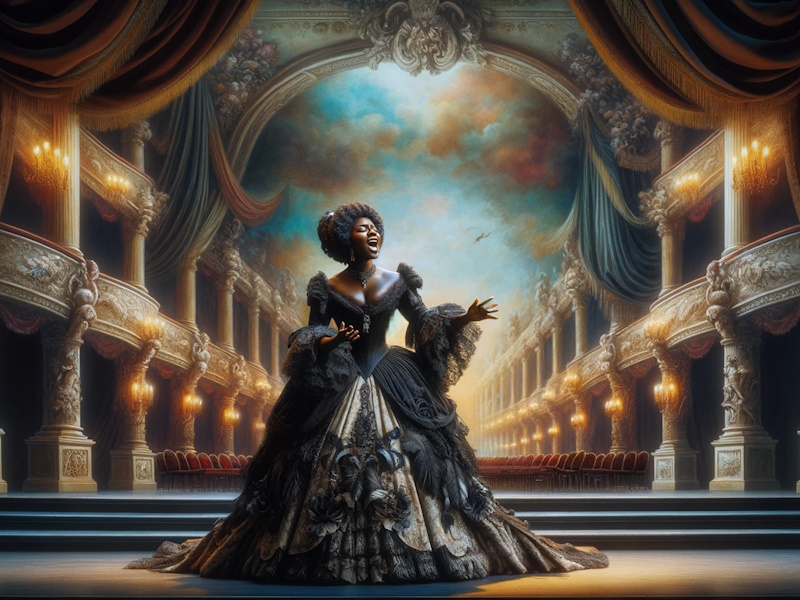It’s important for all musicians to be able to read from a full score and to know about common ensembles, even ones in which they don’t play. This primer is meant as an introduction to score reading and orchestration.
Post Navigation
Navigate to your area of interest:
ENSEMBLE INFORMATION
Common Chamber Ensembles | Common Large Ensembles | Typical Symphony Orchestras
TRANSPOSITION AND DOUBLINGS
General Info | Why Do We Have Transposing Instruments?
Transpositions and Doublings for: Winds | Brass | Strings | Percussion/Keyboard
OTHER INFORMATION
Native Clefs | Common Orchestration Terms | Special Notation
REFERENCES AND RESOURCES
References | Resources
Common Chamber Ensembles
Here are some common chamber ensembles that you should know:
- Brass Quintet: 2 Trumpets (possibly cornets); French Horn; Trombone (possibly Euphonium); Tuba (possibly bass trombone)
- Piano Duet: Two pianists either at one hand (piano, four hands) or at two pianos
- Piano Quartet: Piano + String Trio (violin, viola, cello)
- Piano Quintet: Piano + String Quartet (2 violins, viola, cello)
- Piano Trio: Piano; Violin; Cello
- Pierrot Ensemble: Flute (possibly doubling on piccolo, alto flute); Clarinet (usually in B-flat, possibly doubling on other clarinets and/or bass clarinet); Violin; Cello; Piano; Percussion (or voice)
- String Quartet: 2 Violins (Violin I, Violin II); Viola; Cello
- String Quintet: String Quartet + 1 additional string instrument (usually viola, cello, or double bass)
- String Trio: Violin; Viola; Cello
- Woodwind (or Wind) Quintet: Flute (possibly doubling on piccolo, alto flute); Clarinet (usually in B-flat, possibly doubling on other clarinets, bass clarinet); Oboe (possible doubling on English Horn); Bassoon (possibly doubling on Contrabassoon); French Horn
Common Large Ensembles
Similarly, here are some common large ensembles that you should know:
- Concert Band: A large band that can vary in size and makeup. An ideal concert band would look something like this: 10 flutes (one doubling picc.); 2 oboes (one doubling Eng. Hn.); 2 Bassoons (one doubling CBsn.); 1 E-flat clarinet; 18 B-flat clarinets; 4 alto clarinets; 4 bass clarinets; 2 contrabass clarinets; 2 alto saxes; 1 tenor sax; 1 baritone sax; 9 trumpets; 8 French horns; 6 trombones; 2 baritones; 4 tubas; 1 string bass; 1 electric bass; percussion (full section of percussion instruments); timpani (4 drums)
- Jazz Band: Saxophones (alto, tenor, and baritone), Brass (trumpets, tenor trombones, bass trombones), Rhythm Section (Piano, Bass, Drums); possibly additional instruments
- Studio Orchestra: A cross between a jazz band and symphony orchestra (instrumentation varies)
- Symphony Orchestra: See below.
Typical Symphony Orchestras
While symphony orchestras vary significantly in size and makeup, here’s what you can generally expect. The size of an orchestra is often given by the number of wind players on each part: “Winds by twos” or “Winds by threes,” for instance. Orchestras may also add instruments outside of those listed here, including piano, organ, saxophone, choir, and others.
|
Small Orchestra
|
Medium Orchestra (winds by twos) |
Large Orchestra (winds by threes) |
||
| Woodwinds | Piccolo | 0-1 | 0-1 (3rd flute) | |
| Flute | 1 | 2 | 3 or 2+picc | |
| Oboe | 1 | 2 | 3 or 2+Eng Hn. | |
| English Horn | 0-1 (3rd Ob.) | |||
| Clarinet | 1 | 2 | 3 or 2+B. Cl. | |
| Bass Clarinet | 0-1 (3rd Cl.) | |||
| Bassoon | 1 | 2 | 3 or 2+ CBsn. | |
| Contrabassoon | 0-1 (3rd Bsn.) | |||
| Brass | French Horn | 1-2 | 4 | 4-6 |
| Trumpet | 0-1 | 2-3 | 3 | |
| Trombone | 0-1 | 3 | 3 | |
| Tuba | 1 | 1 | ||
| Percussion | Percussionists | 1 | 2 | 3+ |
| Timpanist | 1 | 1 | 1 | |
| Harp | Harp | 0-1 | 0-1 | 0-2 |
| Bowed Strings | 1st Violins | 4-8 | 8-12 | 12-16 |
| 2nd Violins | 3-6 | 6-10 | 10-14 | |
| Violas | 2-4 | 4-8 | 8-12 | |
| Cellos | 2-3 | 3-6 | 6-10 | |
| Double Basses | 1-3 | 3-6 | 6-10 | |
| TOTAL PLAYERS | 19-35 | 45-66 | 69-89+ |
This chart is adapted from: Kennan, Kent Wheeler. The Technique of Orchestration. Englewood Cliffs, NJ, Prentice-Hall, Inc., 1962, p. 4.
Transpositions and Doublings
A large number of instruments transpose. An instrument is said to be a transposing instrument if the note they read (the “written note”) is different from the note you hear (the “sounding note”).
Why Do We Have Transposing Instruments?
The reasons for this are involved, but it often relates to doublings. An instrument is said to double on another instrument if the same player plays both instruments. For instance, a flute player is often expected to double on piccolo, but you’d never ask them to double on cello.
Consider a saxophone player as an example. There are several different standard saxophones: soprano, alto, tenor, baritone, and bass. Because of their different sizes, if you were to blow into them, they would produce different notes. The smaller instruments would sound higher than the lower instruments. Similarly, if you pressed down the same combination of keys on the different saxophones, the notes that sounded would be different based on the size of the instruments. So, in order to produce the same pitch on, for instance, a soprano and alto saxophone, you would need to finger different notes. This is confusing for the player, as they would have to change their fingering based on the notes they’re reading each time they pick up a different saxophone. To simplify matters, composers write to the fingering instead of the sounding note. That is, instead of making the players adjust their fingering, composers change the note, so that when they finger the different notes on the different instruments, the same sound will come out.
So, if players finger the indicated note on the saxophone listed above it, the resulting sound will be the same (A below middle C):

Thus, instead of burdening the player with constantly changing fingerings, the onus falls on the composer or arranger to write the note whose fingering will produce the desired sounding note.
Which Orchestral Instruments Have Transpositions or Doublings?
Here is a chart of all orchestral instruments, with the instrument, the transposition(s), and the typical doublings.
WOODWINDS
In wind sections, it’s typically the last chair player in each instrument that most often plays the doublings. Saxophones are rare in the symphony orchestra, but very common elsewhere.
| INSTRUMENT GROUP | MAIN INSTRUMENT | COMMON DOUBLINGS | RARE DOUBLINGS |
WRITTEN NOTES SOUND
|
| Flutes | Flute | As written | ||
| Piccolo | An octave higher | |||
| Alto Flute | A perfect fourth lower | |||
| Bass Flute | An octave lower | |||
| Contrabass Flute | 2 octaves lower | |||
| Subcontrabass Flute | 2 octaves and a fourth lower or 3 octaves lower | |||
| Oboes | Oboe | As written | ||
| English Horn | A perfect fifth lower | |||
| Oboe d’amore | A minor third lower | |||
| Oboe da caccia | A perfect fifth lower | |||
| Baritone or Bass Oboe | An octave lower | |||
| Heckelphone | An octave lower | |||
| Clarinets | B♭ Clarinet | A major second lower | ||
| A Clarinet | A minor third lower | |||
| Bass Clarinet | A major ninth lower | |||
| D Clarinet | A major second higher | |||
| E♭ Clarinet | A minor third higher | |||
| E♭ Alto Clarinet | A major sixth lower | |||
| Bassett Horn | A perfect fifth lower | |||
| Contrabass Clarinet | Two octaves and a major second lower or an octave and a major sixth lower | |||
| Saxophones | See below | |||
| Bassoons | Bassoon | As written | ||
| Contrabassoon | An octave lower | |||
| Saxophones | Soprano | A major second lower | ||
| Alto | A major sixth lower | |||
| Tenor | A major ninth lower | |||
| Baritone (“Bari”) | A major thirteenth (P8+M6) lower | |||
| Bass | 2 octaves and a major second lower | |||
| Sopranino | Up a minor third |
BRASS
Certain extraordinarily rare brass instruments that are now substituted out by others (including the contrabass and valve trombones) are omitted.
| INSTRUMENT GROUP | MAIN INSTRUMENT | COMMON DOUBLINGS | RARE DOUBLINGS | WRITTEN NOTES SOUND |
| French Horns | French Horn | A perfect fifth lower (1) | ||
| Natural Horn | Depends on the crook (2) | |||
| Wagner Tuba | Down a perfect fifth (3) | |||
| Trumpets | B♭ Trumpet | A major second lower | ||
| C Trumpet | As written | |||
| D Trumpet | A major second higher | |||
| B♭ Piccolo Trumpet | A minor seventh higher | |||
| E♭ Trumpet | A minor third higher | |||
| C Bass Trumpet | An octave lower | |||
| E♭ Bass Trumpet | A major sixth lower | |||
| D Bass Trumpet | A minor seventh lower | |||
| B♭ Bass Trumpet | A major ninth lower | |||
| B♭ Cornet | A major second lower | |||
| B♭ Flugelhorn | A major second lower | |||
| Natural Trumpet | Depends on the crook (2) | |||
| Trombones | Tenor Trombone | As written | ||
| Bass Trombone | As written | |||
| Alto Trombone | As written | |||
| Tubas | Tuba (4) | As written | ||
| Euphonium | As written | |||
| Baritone | As written |
(1) In the old system of notation still seen in less recent scores, the instrument would sound a P5 below where written only in treble clef; when notated in bass clef, it would sound a P4 above where written
(2) Natural horns can only play about 15 different notes from the overtones based on the fundamental. Crooks are different lengths of tubing that changed the fundamental of the instrument, giving it access to a different collection of notes. Crooks were inserted or removed from the instrument as needed. Similarly, trumpets had about eight different used crooks.
(3) Wagner tubas have a confused history with respect to their transposition. They’re usually now transcribed in F, sounding down a perfect fifth. (source)
(4) There are several different tubas from which players can select, but they all sound as written. The sousaphone is sometimes used in bands, but not in orchestras; it also sounds where written. The ophicleide as used historically, but has been replaced now by the tuba; the ophicleide sounds as written.
STRINGS
All orchestral strings sound as written, except double basses, which sound an octave lower than written. This includes a number of strings not typically seen in an orchestra — harpsichord, mandolin, and banjo, all of which sound as written. The guitar and tenor banjo, however, sounds an octave lower than written.
PERCUSSION/KEYBOARD
Most percussion and keyboard instruments sound as written, including:
- Piano
- Timpani
- Marimba
- Vibraphone
- Chimes (Tubular Bells)
- Organ
- Harmonium
Some of them transpose by one or more octaves:
- Xylophone: sounds an octave above where written
- Glockenspiel (AKA: bells or orchestral bells): sounds 2 octaves above where written
- Crotales: sound 2 octaves above where written
- Celesta: sounds an octave above where written
Native Clefs
It can be useful to know which instruments use which clefs. In general, instruments have a single primary clef, but often shift clefs for sections with particularly high or low notes. Some instruments are equally at home in both clefs (French horns, marimbas) or use two clefs simultaneously (piano, harp, harpsichord, marimba, celesta, harmonium).
Here’s a quick table of instruments’ clefs. When a clef is used just for the higher notes an instrument plays, “HN” is indicated; when a clef is used just for the lower notes an instrument plays, “LN” is indicated.
| Clef | Winds | Brass | Strings | Percussion & Keyboard |
 |
Flutes Clarinets Oboes Saxophones |
French Horns HN Trumpets |
Violins Violas HN Cello HN Double Bass HN Guitar Mandolin Banjo HN |
Xylophone Marimba HN Glockenspiel Chimes Vibraphone |
 |
Bassoons | French Horns LN Trombones Tubas |
Cello Double Bass Banjo LN |
Timpani Marimba LN |
 |
Bassoon HN | Tenor Trombone | Cello HN | |
 |
Alto Trombone | Viola | ||
 |
Various instruments of indefinite pitch | |||
 |
Harp | Piano Harp Harpsichord Celesta Harmonium |
||
 |
Organ |
Common Orchestration Terms
Can’t find the term you’re looking for here? Check the list of recommended sources for more information.
a 2 (a 3, etc.): An indication that the passage is to be played by the number of players indicated (2, 3, etc.) from the section. (This is not to be confused with just numbers; “2.” alone would mean that the 2nd chair plays the given section alone.)
Arco: An indication to bow the strings rather than to pluck them (often used to cancel a previous “pizz.” indication).
Bowing: Markings to show the direction of the bow in bowed string parts (see Special Notation below).
Col legno: To be played with the wood (back side) of the bow for a special effect. Col legno battuto indicates to strike the string(s) with the wood of the bow; col legno tratto indicates to bow the string(s) with the wood of the bow (the latter is usually coupled with unmeasured tremolo).
Con sordino (con sord.): With a mute. (To remove the mute, the indication is “senza sord.”)
Divisi (div.): An indication that the players are to split multiple lines or chords into two (or more parts) rather than each player playing both parts. (This is only used as an indication for strings, except in band music.)
Flutter-tongue (Flt., Flz., etc.): An indication to roll an R or make a similar sound to interrupt the flow of air repeatedly in a wind instrument.
I, II, III, IV: An indication to use certain strings. The lower the string, the greater the number. This may also be indicated by “sul” followed by the pitch of the open string. For instance, the lowest string on the violin is the G string. Playing on it may be indicated by IV or “sul G.”
Multiphonic: Sounding two notes at once on a wind or brass instrument.
Ordinario (ord.): An indication used to cancel an atypical way of playing (e.g., col legno), instructing the player to go back to the ordinary way of playing.
Pizzicato (pizz.): An indication for string players to pluck the strings rather than to bow them.
Solo: An indication that one player from the indicated section is to play the given passage.
Sul ponticello (sul pont.): An indication to bow near the bridge for a glassy effect.
Sul tasto: An indication to bow near the fingerboard for a muted effect.
Tutti: An indication that everyone in a section is to play the given passage (often used to cancel a previous indication of a 2, a 3, solo, etc.).
Unisono (unis.): An indication that everyone in a section is to play the given passage, often used to cancel a previous “divisi” indication. (This is only used as an indication for strings, except in band music.)
References
These books were consulted in preparing this guide:
Adler, Samuel. The Study of Orchestration. 3rd ed., New York, W.W. Norton & Company, 2002.
Kennan, Kent Wheeler. The Technique of Orchestration. Englewood Cliffs, NJ, Prentice-Hall, Inc., 1962.
“Notation for The Wagner Tuba.” The Wagner Tuba, www.wagner-tuba.com/notation/. Accessed 4 July 2017.
Solomon, Samuel Z. How to Write for Percussion: a Comprehensive Guide to Percussion Composition. 1st ed., New York, NY, SZSolomon, 2002.
Recommended Resources
Adler, Samuel. The Study of Orchestration. 3rd ed., New York, W.W. Norton & Company, 2002.
Freund, Don. “Instrument Studies for Eyes and Ears.” Instrument Studies for Eyes and Ears, www.music.indiana.edu/department/composition/isfee/.
Kennan, Kent Wheeler. The Technique of Orchestration. Englewood Cliffs, NJ, Prentice-Hall, Inc., 1962.
Read, Gardner. Music notation: a manual of modern practice. New York, NY, Taplinger Pub. Co., 1979.
Solomon, Samuel Z. How to Write for Percussion: A Comprehensive Guide to Percussion Composition. 1st ed., New York, NY, SZSolomon, 2002.
Stone, Kurt. Music Notation in the Twentieth Century: A Practical Guidebook. New York, NY, W.W. Norton, 1980.
Comments
Catch any errors? Have any recommendations for fellow musicians wanting to learn more? Please comment and I may update this blog to reflect your feedback!
©2017 Aaron Alon. All Rights Reserved.











0 Comments